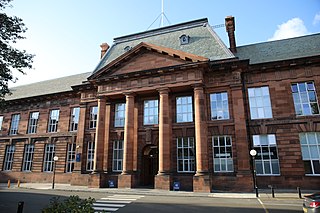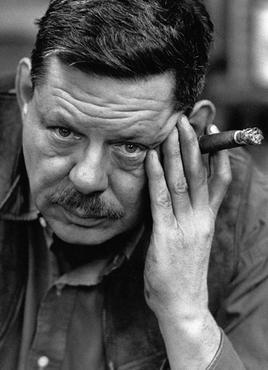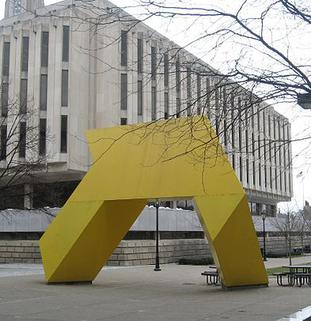Related Research Articles

Edinburgh College of Art (ECA) is one of eleven schools in the College of Arts, Humanities and Social Sciences at the University of Edinburgh. Tracing its history back to 1760, it provides higher education in art and design, architecture, history of art, and music disciplines for over three thousand students and is at the forefront of research and research-led teaching in the creative arts, humanities, and creative technologies. ECA comprises five subject areas: School of Art, Reid School of Music, School of Design, School of History of Art, and Edinburgh School of Architecture & Landscape Architecture (ESALA). ECA is mainly located in the Old Town of Edinburgh, overlooking the Grassmarket; the Lauriston Place campus is located in the University of Edinburgh's Central Area Campus, not far from George Square.

Roland David Smith was an influential and innovative American abstract expressionist sculptor and painter, best known for creating large steel abstract geometric sculptures. Born in Decatur, Indiana, Smith initially pursued painting, receiving training at the Art Students League in New York from 1926 to 1930. However, his artistic journey took a transformative turn in the early 1930s when he shifted his focus to sculpture.
Events from the year 1980 in art.
Events from the year 1961 in art.

Anthony Peter Smith was an American sculptor, visual artist, architectural designer, and a noted theorist on art. He is often cited as a pioneering figure in American Minimalist sculpture.

John Henry Bradley Storrs, also known as John Bradley Storrs and John H. Storrs, was an American modernist sculptor best remembered for his art deco sculptures that examined the relationship between architecture and sculpture.

Bernard J. Rosenthal, also known as Tony Rosenthal, was an American abstract sculptor widely known for his monumental public art sculptures, created over seven decades.

Throwback is a public artwork by American artist Tony Smith, located at the Hirshhorn Museum and Sculpture Garden in Washington, D.C., United States. This version is the third of an edition of three in the series with one artist's proof.

Source is a public artwork by US artist Tony Smith, located in the Cleveland Museum of Art Donna and Stewart Kohl Sculpture Garden, which is in Cleveland, Ohio, United States. The sculpture is fabricated from steel and painted black. It is constructed from two separate pieces that are bolted together.
Smoke is a large-scale sculpture conceived by American artist Tony Smith in 1967 that was fabricated posthumously in 2005 for the Los Angeles County Museum of Art (LACMA) where it was installed in 2008. This two-tier sculptures standing 24 foot tall is made of aluminum and painted black.

Gracehoper is a public artwork by American artist Tony Smith, located in the Louisville Waterfront Park, which is in Louisville, Kentucky. This large-scale sculpture, measuring twenty-two feet high and forty six feet long, was fabricated by Lippincott, Inc in 1988, eight years after Smith's death, at a cost of one million dollars. The sculpture is made of welded steel that has been painted black.

Throwback (1/3) is a public artwork by American artist Tony Smith, located in the Marsh & McLennan Companies (MMC) Plaza at 1166 Avenue of the Americas in Midtown Manhattan, New York City, New York.
Moses (3/3) is a public sculpture of the prophet Moses by United States artist Tony Smith. It is on the grounds of the Toledo Museum of Art in Toledo, Ohio. The title of the work was inspired from readings of his own work that links this sculpture to the work of Michelangelo and Rembrandt.

She Who Must Be Obeyed is a minimalist sculpture 33 feet (10 m) wide and 16 feet (4.9 m) deep made by Tony Smith in 1975. It is located at the Frances Perkins Building, in downtown Washington, D.C. The piece consists of nine geometric rhomboid units, bolted and welded together and painted blue.
Tau, by American sculptor Tony Smith, was designed in the early 1960s. It is 14’ high x 12’ wide x 12’ deep, and made from black painted steel. Its title refers to the Greek letter Τ (tau), which also describes the shape of the sculpture. Fascinated by mathematics, biology and crystals, Smith designed Tau with geometry at its root. There are two extant versions of the large sculpture: Tau (AP), and Tau (1/3).

Light Up, often stylised as Light Up!, is a painted steel plate public art sculpture by American artist Tony Smith and dedicated on May 15, 1974. The sculpture is located in the University of Pittsburgh's Forbes Quadrangle between Posvar Hall, the Barco Law Building, and Hillman Library. Commissioned in 1971 by Westinghouse Electric Corporation, it was originally situated in Gateway Center in downtown Pittsburgh, but was donated to the University of Pittsburgh and relocated to its Oakland campus in 1988. The sculpture was temporarily recited to the Seagram Plaza in New York City in 1998 for an exhibition of Smith's work at the Museum of Modern Art.

Mary Miss is an American artist and designer. Her work has crossed boundaries between architecture, landscape architecture, engineering and urban design. Her installations are collaborative in nature: she has worked with scientists, historians, designers, and public administrators. She is primarily interested in how to engage the public in decoding their surrounding environment.
Trap is a sculpture by American artist Tony Smith which was made in an edition of nine with one artist's proof. This bronze sculpture was designed to be large-scale, but was only realized in bronze of the smaller size in 1968. The bronze was patinated to appear black.
The year 2023 in art will involve various significant events.
References
- ↑ "Tony Smith: Architect, Painter, Sculptor" Robert Storr, p162(The Museum of Modern Art, New York, 1998)
- ↑ "Tony Smith" NJN State of the Arts www.youtube.com/watch?v=HCg3_p46QaA
- ↑ "Tony Smith: Architect, Painter, Sculptor" Robert Storr, p185 (The Museum of Modern Art, New York, 1998)
- ↑ "Hunter College - THE ARTS SYLLABUS - Tau Activity - Prof. John Toth".
- ↑ "Tony Smith: Architect, Painter, Sculptor" Robert Storr, p30(The Museum of Modern Art, New York, 1998)
- ↑ "Talking with Tony" Interview with Tony Smith by Samuel J. Wagstaff (Artforum 5, December 1966)